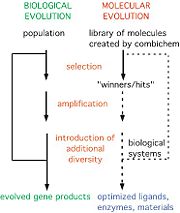
Combinatorial biology
Encyclopedia

Biotechnology
Biotechnology is a field of applied biology that involves the use of living organisms and bioprocesses in engineering, technology, medicine and other fields requiring bioproducts. Biotechnology also utilizes these products for manufacturing purpose...
, combinatorial biology is the creation of a large number of compounds (usually proteins or peptides) through technologies such as phage display
Phage display
Phage display is a method for the study of protein–protein, protein–peptide, and protein–DNA interactions that uses bacteriophages to connect proteins with the genetic information that encodes them. Phage Display was originally invented by George P...
. Similar to combinatorial chemistry
Combinatorial chemistry
Combinatorial chemistry involves the rapid synthesis or the computer simulation of a large number of different but structurally related molecules or materials...
, compounds are produced by biosynthesis
Biosynthesis
Biosynthesis is an enzyme-catalyzed process in cells of living organisms by which substrates are converted to more complex products. The biosynthesis process often consists of several enzymatic steps in which the product of one step is used as substrate in the following step...
rather than organic chemistry
Organic chemistry
Organic chemistry is a subdiscipline within chemistry involving the scientific study of the structure, properties, composition, reactions, and preparation of carbon-based compounds, hydrocarbons, and their derivatives...
. This process was developed independently by Richard A. Houghten
Richard A. Houghten
Richard A. Houghten is a heterocyclic organic chemist and founder of the journal Peptide Research, which was later merged with the International Journal of Peptide and Protein Research, to become the Journal of Peptide Research. His work mainly concerns peptide activity and pharmacology...
and H. Mario Geysen in the 1980s. Combinatorial biology allows the generation and selection of the large number of ligands for high-throughput screening
High-throughput screening
High-throughput screening is a method for scientific experimentation especially used in drug discovery and relevant to the fields of biology and chemistry. Using robotics, data processing and control software, liquid handling devices, and sensitive detectors, High-Throughput Screening allows a...
.
These large numbers of peptides are generated and screened by physically linking a gene encoding a protein and a copy of this protein. This could involve the protein being fused to the M13 minor coat protein pIII, with the gene encoding this protein being held within the phage particle. Large libraries of phages with different proteins on their surfaces can then be screened through automated selection and amplification for a protein that binds tightly to a particular target.
External links
- Combinatorial Biology Argonne National Laboratory: Biosciences Division

